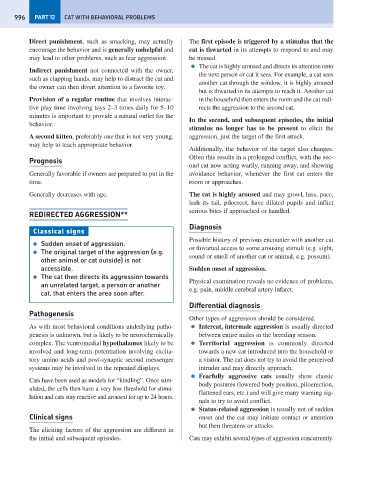Page 1004 - Problem-Based Feline Medicine
P. 1004
996 PART 12 CAT WITH BEHAVIORAL PROBLEMS
Direct punishment, such as smacking, may actually The first episode is triggered by a stimulus that the
encourage the behavior and is generally unhelpful and cat is thwarted in its attempts to respond to and may
may lead to other problems, such as fear aggression. be missed.
● The cat is highly aroused and directs its attention onto
Indirect punishment not connected with the owner,
the next person or cat it sees. For example, a cat sees
such as clapping hands, may help to distract the cat and
another cat through the window, it is highly aroused
the owner can then divert attention to a favorite toy.
but is thwarted in its attempts to reach it. Another cat
Provision of a regular routine that involves interac- in the household then enters the room and the cat redi-
tive play time involving toys 2–3 times daily for 5–10 rects the aggression to the second cat.
minutes is important to provide a natural outlet for the
In the second, and subsequent episodes, the initial
behavior.
stimulus no longer has to be present to elicit the
A second kitten, preferably one that is not very young, aggression, just the target of the first attack.
may help to teach appropriate behavior.
Additionally, the behavior of the target also changes.
Often this results in a prolonged conflict, with the sec-
Prognosis
ond cat now acting warily, running away, and showing
Generally favorable if owners are prepared to put in the avoidance behavior, whenever the first cat enters the
time. room or approaches.
Generally decreases with age. The cat is highly aroused and may growl, hiss, pace,
lash its tail, piloerect, have dilated pupils and inflict
serious bites if approached or handled.
REDIRECTED AGGRESSION**
Diagnosis
Classical signs
Possible history of previous encounter with another cat
● Sudden onset of aggression.
or thwarted access to some arousing stimuli (e.g. sight,
● The original target of the aggression (e.g.
sound or smell of another cat or animal, e.g. possum).
other animal or cat outside) is not
accessible. Sudden onset of aggression.
● The cat then directs its aggression towards
Physical examination reveals no evidence of problems,
an unrelated target, a person or another
e.g. pain, middle cerebral artery infarct.
cat, that enters the area soon after.
Differential diagnosis
Pathogenesis
Other types of aggression should be considered.
As with most behavioral conditions underlying patho- ● Intercat, intermale aggression is usually directed
genesis is unknown, but is likely to be neurochemically between entire males in the breeding season.
complex. The ventromedial hypothalamus likely to be ● Territorial aggression is commonly directed
involved and long-term potentiation involving excita- towards a new cat introduced into the household or
tory amino acids and post-synaptic second messenger a visitor. The cat does not try to avoid the perceived
systems may be involved in the repeated displays. intruder and may directly approach.
● Fearfully aggressive cats usually show classic
Cats have been used as models for “kindling”. Once stim-
body postures (lowered body position, piloerection,
ulated, the cells then have a very low threshold for stimu-
flattened ears, etc.) and will give many warning sig-
lation and cats stay reactive and aroused for up to 24 hours.
nals to try to avoid conflict.
● Status-related aggression is usually not of sudden
Clinical signs onset and the cat may initiate contact or attention
but then threatens or attacks.
The eliciting factors of the aggression are different in
the initial and subsequent episodes. Cats may exhibit several types of aggression concurrently.

